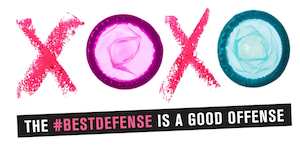Talking to our children about about keeping healthy is one of the job requirements of parenting. From the minute they are fresh out of the oven, I mean womb, we immediately attach them to our breast. Heaven forbid they go too long without a nutritious meal.
From there it escalates. Frequent feedings, plenty of rest, bundling up our bundles of joy for security and warmth. As our children grow, we offer them healthy options at mealtime, ensure they have the appropriate clothing for the weather, and insist they wear bike helmets as they zoom into the world. Suddenly they are in middle school and making independent decisions about their health. You ponder, “Did I tell them everything they need to know so they will make wise decisions?” Well, probably not.
What was forgotten?
One topic that is oftentimes tossed aside until “later” is the conversation about human immunodeficiency virus, or HIV. Certainly that is a topic that is irrelevant during the middle school years, right?
Wrong.
Educating young people about HIV and other sexually transmitted infections (STI’s) in middle school, before they become sexually active, is the best time to provide them with information and arm them with strategies to stay healthy before they are faced with sexual situations.
The CDC statistics about HIV speak for itself:
- Half of young people infected with HIV do not know they have it.
- One-quarter of new HIV infections are diagnosed in the 13-24 year old age group, even though they reflect only 17% of the population.
- The age group with the most HIV diagnoses (in 2013) were those aged 20-24.
HIV is an “everyone” disease. Granted, most of those infected tend to be gay males, however females are not immune. In the United States, 1/4 of those with HIV are female, with 81% having contracted the disease within a heterosexual relationship.
Because it is National Women and Girls HIV/AIDS Awareness Day, we will focus on talking points with your daughters. However, the same conversations must be made with your sons. Womenshealth.gov is a terrific resource for more information.
- HIV is not AIDS (acquired immunodeficiency syndrome). HIV is the virus that causes AIDS. HIV can be treated, though not cured. Read more here and here and here.
- Condoms can prevent the spread of HIV and some other STI’s when used properly. Use condoms for anal, vaginal, and oral sex.
- HIV may not show any symptoms. Testing of both partners for HIV/STI’s before beginning a sexual relationship is a must.
- Women contract HIV more easily than men. If a woman already has an STI, it also makes it easier to contract HIV.
- HIV enjoys diverse populations; it does not discriminate on age, sex, orientation, race, or ethnicity.
- For those at high-risk of contracting HIV from an infected partner, there are medications available. PrEP can help prevent HIV from infecting a person. PEP is used to help lower your chances of getting HIV after exposure from an infected partner.
- Women in abusive situations may find it difficult to get assistance, so it is important to talk about what healthy and unhealthy relationships looks like.
- Define values, goals, dreams. Make decisions about becoming sexually active and safer sex practices based on those values.
Abstinence is the only 100% method to prevent HIV/STI’s and pregnancy. However, using the following guidelines can help those who are sexually active stay healthy.
HIV/STI Prevention Basics: M.A.T.C.H.
- When not abstinent, engage in a mutually Monogamous relationship.
- Avoid Alcohol and other drugs: People sometimes makes decisions they normally would not when sober. For proof, just listen to the Joe Nichols song, “Tequila Makes Her Clothes Fall Off.”
- Both partners should get Tested for HIV and all STI’s before sexual contact. Click on this CDC link to locate nearby testing facilities.
- Use a male or female Condom…everytime you have sex. Any kind of sex.
These four simple guidelines can help those who are sexually active stay Healthy.
Finally, be nice to those who have HIV. There is no place for bullying and teasing in this world. Listen as Paige Rawl speaks about her experience.
For more information about HIV/AIDS, the following resources are excellent.



